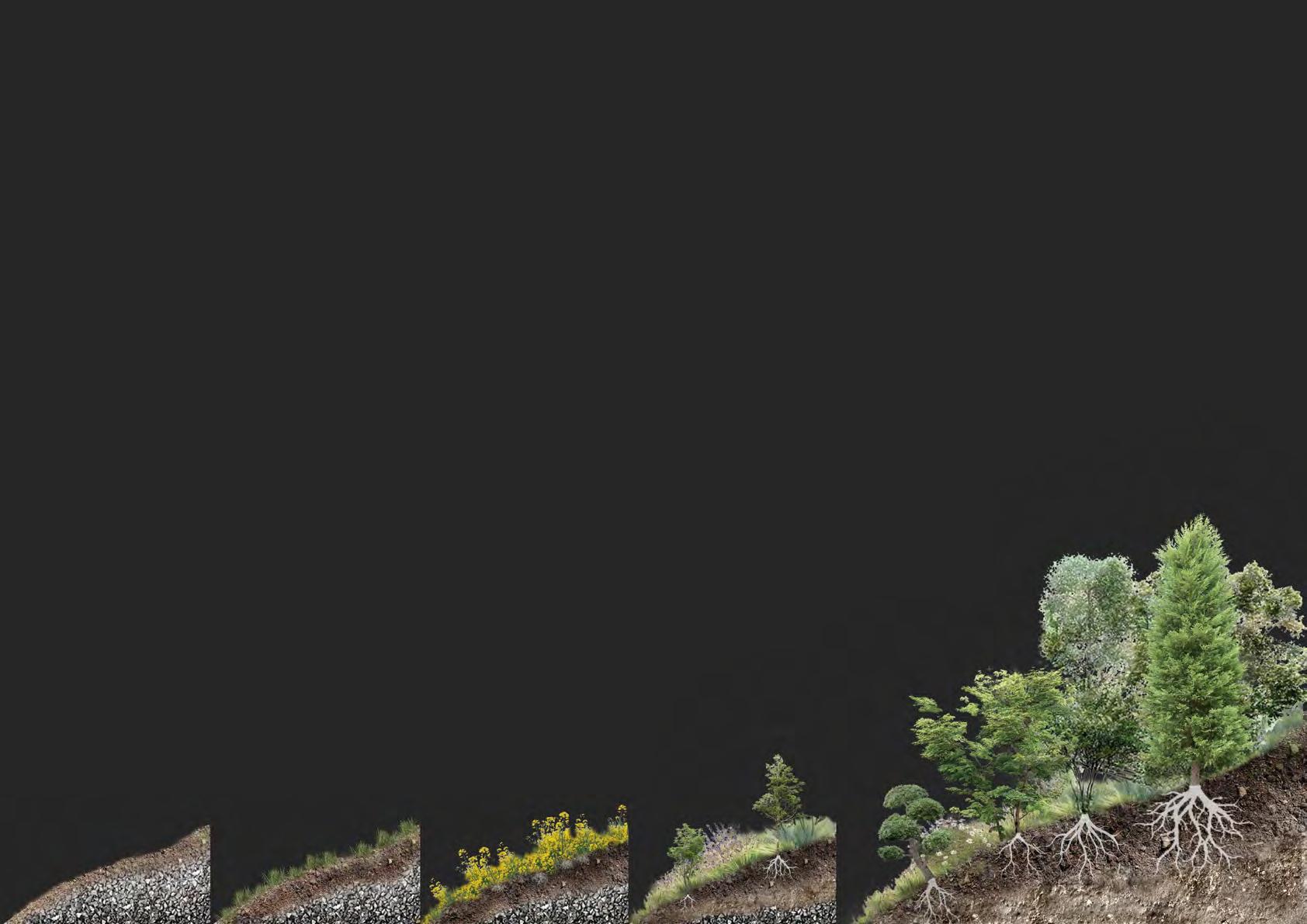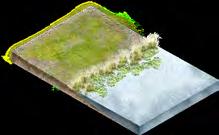













Green Penetration
Baiyun Obo Mining Area, affiliated to Baotou City, Inner Mongolia Autonomous Region, is located in the north of Yinshan Mountain, with an area of 328.64 square kilometers and a built-up area of 10 square kilometers. The mine is currently abandoned, but after years of development, the ecological environment around the mine has been severely damaged. Rainwater will collect at the bottom of the pit, but due to the harsh ecological environment, heavy metals in the water seriously exceed the standard.
Mine Ecological Restoration Design
Geological Analysis

Organic layer
Topsoil
Niobium-bearing potassium-rich slate
Ferroniobium rare earth ore body
Rare earth dolomite
Hercynian granite
Shale with limestone
Existing Problems
Pebbled sandstone
Rainfall Analysis
Crushed stone
Equipment stacking place
Sheer faces
Industrial building area
Stagnant water area
Rainwater accumulates at the bottom of the pit, and the water contains heavy metal elements that cause fish to mutate and are harmful to surrounding birds.
Due to long-term excavation, gravel often rolls down the rock wall, endangering people's lives.
The long-term mine development has seriously damaged the ecology of the area, and the environment without green plants is very dusty.
There are very few people living around the mining area, so a lot of garbage is piled up, and no one cleans it, making the ecological environment very bad.
0 50 100 N 200m
month
Littoral sandstone
1 2 3 4 5 6 7 8 9 10 11 12
04
Strategy









The strategy of pit restoration is mainly reflected in three aspects, namely soil restoration, water purification and human activities. Soil restoration is done mainly by planting Indian mustard, sunflower, etc. Purification of water sources is mainly done by cultivating river mussels, grass carp, and planting reeds and cattail grass. Human activities are mainly completed by building plank roads, lawns, and commemorative landscapes.








After
















Framwork Mine Wetland Park Soil Sunflower Poplar Indian mustard Sow Trees Viewing platform Foot path Water boardwalk Falls Rock climbing Animals Grass Fish Shrimp Transform Green Human Lake Reeds Mussel farming Soil remediation Clean water Purify water Terrain Sewage
first type of terrain is a cliff with a slope greater than 45 degrees, which is widely located in the middle and upper walls of the pit
The
the mine
currently four types of terrain, namely cliffs with a slope greater than 45 degrees, steep slopes of 15-45 degrees, gentle slopes of 5-15 degrees, and flat lands of 0-5 degrees.
is developed, there are
The third type of landform is a gentle slope with a slope of 5-15 degrees, which is basically located at the bottom of the pit, and partly located at the waterfront.
second type of terrain is a steep slope with a slope of 15-45 degrees, which is basically located in the middle and lower part of the pit. The fourth kind of landform is flat land with a slope of 0-5 degrees. This landform is also basically located at the bottom of the mine pit
Site Status Operation Terrain 1 Terrain 1 Terrain 3 Terrain 3 Terrain 2 Terrain 2 Terrain 4 Terrain 4 Steep Steep Gentle Gentle Medium Medium Plain Plain Cliff Steep( >45°) Medium( 15° - 45°) Gentle( 5° -15°) Gentle( 0° - 5°) Drop-off Slpoe Flat Aquaculture Aquatic planting Water boardwalk Rock climbing Soil remediation Site memory Boulevard Water space Forest Terrace landscape Cliff path Waterfall After development, the inner walls of the pit have many very steep terrains, similar to cliffs Steep slopes in parts of the middle and bottom of the pit There are many gentle slopes along the waterfront at the bottom of the pit The terrain at the bottom of the pit is basically flat, and rainwater collects here to form small lakes The mine water contains heavy metals, and mussels and fish can be cultivated to purify the water quality Reeds, lotus and other plants can be planted in the waterfront wetlands to purify water and create landscapes Build a plank road on the wetland, people can enter the quiet distance to watch the birds The rock
provide venues for rock climbers Soil remediation using machines and artificial planting Indian mustard Willow Poplar Sunflower Mussel Cattail grass White spoonbill Bean goose White Stork Reeds Lotus Grass Carp Silver carp Use abandoned water pipes and mechanical parts as a memorial landscape in the site. Build meandering tree-lined paths in gently sloping terrain The waterfront green space provides a leisure space for people to lie down and rest Stabilize the soil and prevent soil erosion by planting trees Steep slope terrain can be transformed into a layered terraced landscape
walkway
cliff
tourists to better enjoy the scenery In part of the pit,
can be used as a waterfall landscape
The
and is the place where the mine pit accumulates water.
walls left by mining
A
is dug on the
to allow
the drop of the cliff
Landscape revival of pit space

The site is a mining pit terrain, and the restoration of the mine pit landscape is mainly to re-energize the site. The terrain in the site can be roughly divided into four types according to the slope. According to the characteristics of each slope, different landscape types can be made, such as cliff plank road, waterfront platform, terrace landscape, etc., which can re-stimulate the vitality of the site.
Site Analysis
In this section, we can see the terrain change of the mine pit from north to south, and the different landscape types generated under each terrain.
Section A-A
Main tourist trail
Secondary tourist trail
Vegetation area
Water area
Platform
Activity area
Viewing area
planting Water boardwalk 0 40 80 160m A A N Falls
1 3 4 5 6 7 8 9 10 11 12 2 1.
2.
3.
4. Water
5.
farming 6. Site memory 7. Cliff Plank Path 8. Cliff climbing 9. Lawn activities 10. Wetland landscape 11. Viewing platform 12. Woods path Soil remediation area Forest Tourist Area Water restoration area Waterfall Tourist Area
Poplar Footpath Viewing Platform Mussel farming Shrimp Grass Carp Reeds
Indian mustard
Visitor center
Activity platform
Water fall
boardwalk
Mussel
Soil remediation







Soil physical remediation is mainly to remove or separate pollutants from soil through various physical processes.
Soil Chemical remediation refers to adding chemicals to soil to remove pollutants in soil through redox of heavy metals and organic substances



Soil bioremediation is the use of the unique ability of organisms to decompose toxic and harmful substances to remove pollutants in the soil.
Plant configuration








Main insect species in the pit






After several years of soil restoration, the soil fertility has gradually improved, enabling a variety of plants to thrive here, and many animals to inhabit here, making the entire mine ecosystem reach a virtuous circle, and finally forming a lush forest.


































SVE monitoring well Extraction well Pressure gauge Flow meter Blower Gas-liquid separator Polluted area Air flow route Water level Physical restoration 0y
3y 6y 10y 20y Chemical restoration Bioremediation
Gas processing unit Coarse particles Fine particles Pollutants Indian mustard Willow Poplar Sunflower Loach Ginkgo Beijing mockorange Ash Butterfly Butterfly
Arbor Shrub Cover Plants Ants Monomorium pharaonis Formica gigantea Loewe's ant Stinking ant worker-priest Colias Swallowtail Butterfly Vanessa Skipper Satyr Orychophragmus violaceus The main pollutants in mine soil Soil Remediation Comparison Soil remediation method Cadmium 0.00% 1.00% 1.60% 2.00% 2.70% 2.10% 1.50% 1.10% 0.90% 4.80% 0 500 3.80 4.00 4.20 4.40 4.60 4.80 5.00 5.20 5.40 Physical separation In site incineration Bioremediation Thermal desorption Off site incineration Solidification Other offsetting techniques Other in situ techniques Soil evaporation extraction Chemical treatment Polyphase extraction Rinse 1000 1500 2000 2500 3.00% 4.00% 5.00% 6.00% 7.00% 7.00% 8.00% Mercury Arsenic Copper Lead Chromium Zinc Nickel Before repair Regulate tillage Plants repair After repair Spiraea White
Bellow
Weigela
Sunflower Ophiopogon
Clove Triceratops Indian
Aster
Thyme Berberis thunbergii Berberis Holly Euonymus Ligustrum
Phellodendron
Soil PCBs content /ug kg Soil ph
clover
fruit Artemisia
argyi
florida
Astragalus
pubescens
japonicus
mustard
Sorbaria sorbifolia
quihoui Honeysuckle
creeper
Fern Baiqian
Metasequoia Poplar Poplar Weeping willow Pyrus betulaefolia Sabina chinensis Magnolia grandiflora Toona sinensis Catalpa Sophora xanthantha
Water restoration

Aquatic plants are placed in the polluted waters of the mine, and plants with both water purification, ornamental and economic value are planted on the island formed by them, such as reeds, lotus, etc. The roots of aquatic plants have adsorption and absorption functions. The biochemical degradation of microorganisms and other processes can improve and purify the water quality, so that the water quality of the water area will continue to improve.

Emergent plant








At the beginning, the water source in the mine was seriously polluted, with heavy metal content exceeding the standard. There were basically no living things in the water, and there were basically no green plants in the mine.


Plant reeds, lotus and other plants in the water that can absorb pollutants and purify the water source. Plants are also used around the water source to improve the soil quality.


After the water quality is improved to a certain extent, the aquatic animals such as mussels and oysters will be cultivated to further improve the water quality.
Producing
Through the photosynthesis of plants, oxygen is transmitted to the root system, and biofilm is formed on the bottom surface of aquatic plants, which plays the role of contact oxidation and continuously removes pollutants in water. Plant roots secrete flocculants to promote the removal of suspended solids in water and improve the visibility of water bodies.

Wetland animals and plants
















The water quality was further improved, the aquatic plants on the shore grew naturally, and the fish and shrimp in the water increased, gradually achieving the goal of ecological balance.









The mine pit has become a wetland ecological environment. A large number of creatures come here and attract a large number of tourists.


Aquatic plants and fish form a stable ecological chain in the water to achieve the purpose of continuous water purification without power.
Floating leaf plants


Floating plants
Submerged plants
Microbial degradation Oxygen Excrement Ammonia Nitrite Nitric acid Nitrogen Decomposition Decomposition Rot Carbon dioxide
Photosynthesis Photosynthesis Reduce sediment nitrification Inorganic pollutants Aerobic pollutant Pathogenic microorganism Heavy metal Phytonutrients
Hygrophyte
biological
flocculant
Arsenic Manganese Mercury Cadmium Copper Lead chromium 0.00% 1.00% 2.00% 3.00% 4.00% 5.00% 6.00% 7.00% 8.00% Taro
Fish
Water
Asparagus Tilapia
Egret Sleeping
Silver
Wild
Reed
Lotus
Alack
Sedge
Water
Scirpus
Aquatic plants
Bird Herring White bellied Egret
anise catfish Stork
mossambica
vegetable
carp
goose
carp Red-crowned crane
Crucian carp Swan goose
algae ricefield eel Spoon-billed Sandpiper
snakehead Pelican
hyacinth Freshwater perch Swan
Tabernaemontani Grass Carp Crested Ibis
Main pollutants in water Aquatic plants purify water Wetland ecosystem Changes in water quality over time Abandoned mine Plants remediation Aquatic animal remediation Ecological equilibrium Wetland Park Plant type distribution 0y 1y 2y 3y 5y




















































